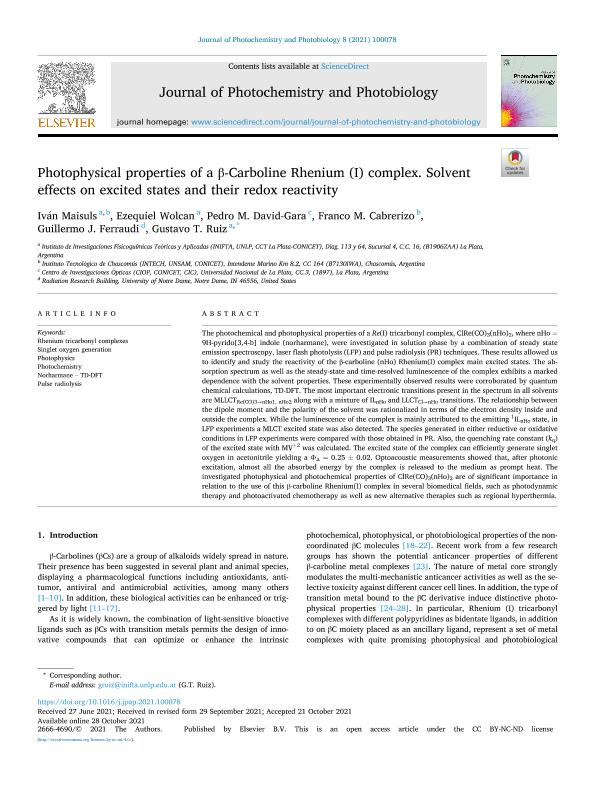Artículo
Photophysical properties of a β-Carboline Rhenium (I) complex. Solvent effects on excited states and their redox reactivity
Maisuls, Iván ; Wolcan, Ezequiel
; Wolcan, Ezequiel ; David Gara, Pedro Maximiliano; Cabrerizo, Franco Martín
; David Gara, Pedro Maximiliano; Cabrerizo, Franco Martín ; Ferraudi, Guillermo J.; Ruiz, Gustavo Teodosio
; Ferraudi, Guillermo J.; Ruiz, Gustavo Teodosio
 ; Wolcan, Ezequiel
; Wolcan, Ezequiel ; David Gara, Pedro Maximiliano; Cabrerizo, Franco Martín
; David Gara, Pedro Maximiliano; Cabrerizo, Franco Martín ; Ferraudi, Guillermo J.; Ruiz, Gustavo Teodosio
; Ferraudi, Guillermo J.; Ruiz, Gustavo Teodosio
Fecha de publicación:
12/2021
Editorial:
Elsevier
Revista:
Journal of Photochemistry and Photobiology
ISSN:
2666-4690
Idioma:
Inglés
Tipo de recurso:
Artículo publicado
Clasificación temática:
Resumen
The photochemical and photophysical properties of a Re(I) tricarbonyl complex, ClRe(CO)3(nHo)2, where nHo = 9H-pyrido[3,4-b] indole (norharmane), were investigated in solution phase by a combination of steady state emission spectroscopy, laser flash photolysis (LFP) and pulse radiolysis (PR) techniques. These results allowed us to identify and study the reactivity of the β-carboline (nHo) Rhenium(I) complex main excited states. The absorption spectrum as well as the steady-state and time-resolved luminescence of the complex exhibits a marked dependence with the solvent properties. These experimentally observed results were corroborated by quantum chemical calculations, TD-DFT. The most important electronic transitions present in the spectrum in all solvents are MLLCTRe(CO)3→nHo1, nHo2 along with a mixture of ILnHo and LLCTCl→nHo transitions. The relationship between the dipole moment and the polarity of the solvent was rationalized in terms of the electron density inside and outside the complex. While the luminescence of the complex is mainly attributed to the emitting 1ILnHo state, in LFP experiments a MLCT excited state was also detected. The species generated in either reductive or oxidative conditions in LFP experiments were compared with those obtained in PR. Also, the quenching rate constant (kq) of the excited state with MV+2 was calculated. The excited state of the complex can efficiently generate singlet oxygen in acetonitrile yielding a ΦΔ = 0.25 ± 0.02. Optoacoustic measurements showed that, after photonic excitation, almost all the absorbed energy by the complex is released to the medium as prompt heat. The investigated photophysical and photochemical properties of ClRe(CO)3(nHo)2 are of significant importance in relation to the use of this β-carboline Rhenium(I) complex in several biomedical fields, such as photodynamic therapy and photoactivated chemotherapy as well as new alternative therapies such as regional hyperthermia.
Archivos asociados
Licencia
Identificadores
Colecciones
Articulos(CCT - LA PLATA)
Articulos de CTRO.CIENTIFICO TECNOL.CONICET - LA PLATA
Articulos de CTRO.CIENTIFICO TECNOL.CONICET - LA PLATA
Citación
Maisuls, Iván; Wolcan, Ezequiel; David Gara, Pedro Maximiliano; Cabrerizo, Franco Martín; Ferraudi, Guillermo J.; et al.; Photophysical properties of a β-Carboline Rhenium (I) complex. Solvent effects on excited states and their redox reactivity; Elsevier; Journal of Photochemistry and Photobiology; 8; 100078; 12-2021; 1-10
Compartir
Altmétricas



